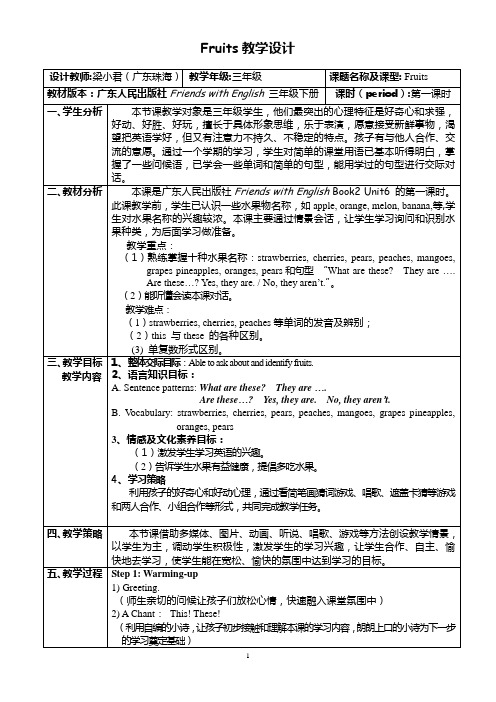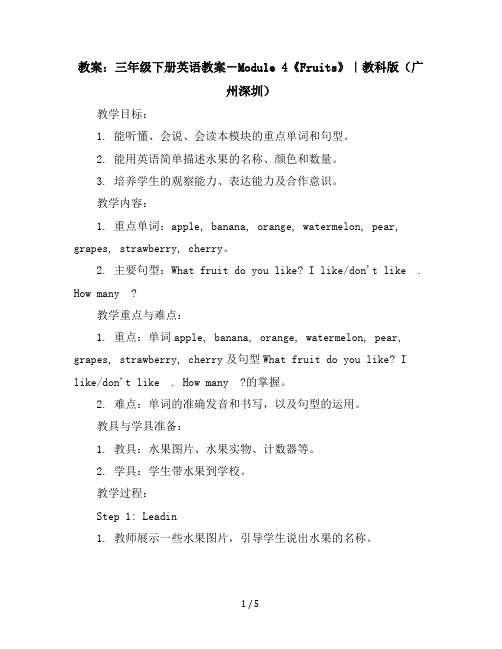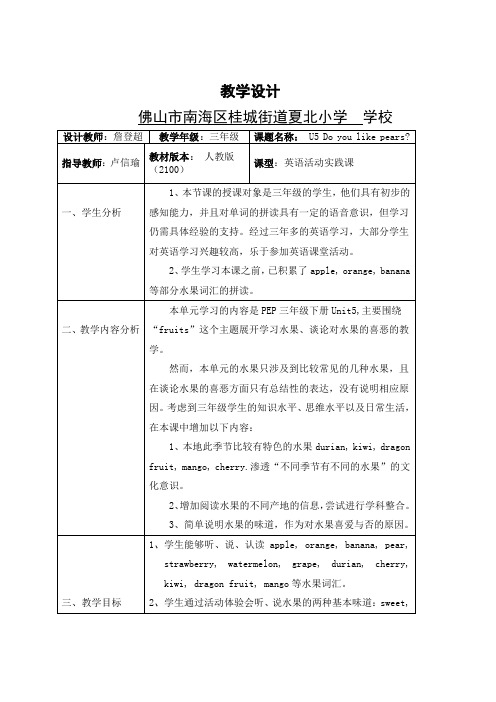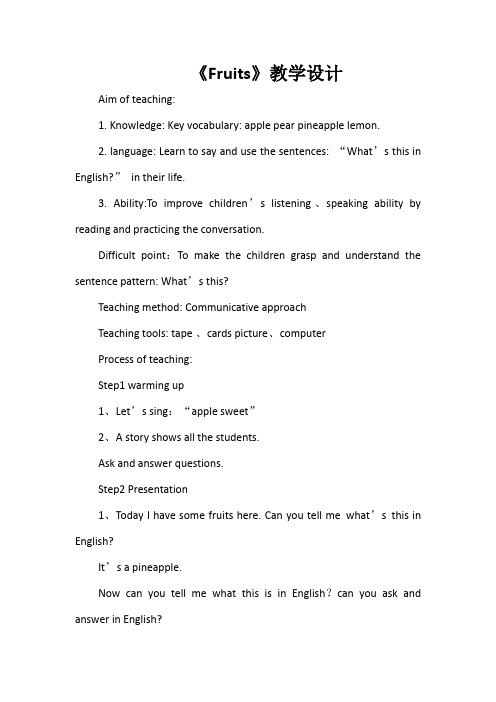小学英语《 Fruits》教学设计
- 格式:doc
- 大小:14.50 KB
- 文档页数:3

![[英语教案]小学英语《Fruits》教学设计](https://img.taocdn.com/s1/m/f0576ced5ebfc77da26925c52cc58bd6318693b5.png)
[英语教案]小学英语《Fruits》教学设计Teaching goals:Part A in this unit.Go over the sentence patterns that have been learnt, such as “What colour is it? What do you like?I like bananas. ……”The important points:Sentence pattern: Is this a banana? Yes, it is./ No, it isn’t. Words: banana mango lemon pineapple watermelon pear Difficult points:This is a market. It isn’t a classroom!Preparation:tape recorder, cards, computer and TV.Teaching steps:Step 1:GreetingsT: Good morning, boys and girls!Nice to see you again!How’s it going?Step 2:Presentation of the words1. T shows an apple and asks: What’s this?Ss: ( It’s an ) apple.T: Yes, it’s an apple. Pass the apple and practice: It’s an apple.(one by one)T: This is an apple. Pass and practice: This is an apple.2. T shows an orange and say: This is an orange. Pass andpractice: This is an orange.3. T shows a banana and say: This is a _banana_. Pass andpractice.4. T shows a mango and say: This is a _mango_. Pass andpractice.Play games to consolidate the words:Game 1: Show slides and let Ss guess: What’s this?T will ask some students to point and say: This is a…( Have a match between boys and girls)Game 2: Listen and show me the fruit.Step 2: Presentation of the sentence pattern1. T shows a mango and asks: Is this a mango? Ss: Yes, it is. T writes on the Bb: Yes, it is. Practice: Yes, it is.2. T shows the mango and asks: Is this an apple? Ss: No (itisn’t).Practice: No, it isn’t.T writes on the blackboard: No, it isn’t.T points to the blackboard and ask: What should we fill in the four-line blanks?Ss: Is this a mango?T fills in the blanks.Practice reading the sentence.Step 3:Play games to consolidate the sentence pattern and the words.Game 1: Touch and guess: Is this a …?Game 3: Have a listening comprehension test:Listen to the dialogues and do the exercises: (draw in theblanks)1. It’s a _________.2. This is a __________.3. It’s an _________.4. This is a ________.5. This is a ______. It isn’t a classroom!Step 4: PracticeLet’s listen to the tape and practice reading the tape. Perform the dialogues in pairs or groups.Talk about the fruits you like.Step 5: Do some exercises on the workbook.Step 6: Homework:1.上网查找关于水果的谚语。

教案:三年级下册英语教案-Module 4《Fruits》|教科版(广州深圳)教学目标:1. 能听懂、会说、会读本模块的重点单词和句型。
2. 能用英语简单描述水果的名称、颜色和数量。
3. 培养学生的观察能力、表达能力及合作意识。
教学内容:1. 重点单词:apple, banana, orange, watermelon, pear, grapes, strawberry, cherry。
2. 主要句型:What fruit do you like? I like/don't like . How many ?教学重点与难点:1. 重点:单词apple, banana, orange, watermelon, pear, grapes, strawberry, cherry及句型What fruit do you like? I like/don't like . How many ?的掌握。
2. 难点:单词的准确发音和书写,以及句型的运用。
教具与学具准备:1. 教具:水果图片、水果实物、计数器等。
2. 学具:学生带水果到学校。
教学过程:Step 1: Leadin1. 教师展示一些水果图片,引导学生说出水果的名称。
2. 学生带来水果实物,教师引导学生用英语描述水果的颜色和数量。
Step 2: Presentation1. 教师通过展示水果图片,引入本节课的单词:apple, banana, orange, watermelon, pear, grapes, strawberry, cherry。
2. 教师引导学生跟读单词,注意发音和拼写。
Step 3: Practice1. 教师组织学生进行小组活动,学生互相用英语描述水果的颜色和数量。
2. 学生用本节课的单词和句型编写小对话,并进行角色扮演。
Step 4: Consolidation1. 教师组织学生进行水果拼盘活动,学生用英语交流,练习本节课的单词和句型。


2024年小学英语水果完整fruits课件一、教学内容本节课的内容选自小学英语教材《牛津小学英语》3B的Unit 5 “Fruits”章节。
详细内容包括水果词汇的学习,如apple, banana, orange, strawberry, grape等;一般现在时的运用,描述喜欢的水果;以及通过水果主题展开的简单对话。
二、教学目标1. 学生能够掌握并运用与水果相关的英语词汇。
2. 学生能够使用一般现在时描述自己喜欢的水果。
3. 学生能够在实际情景中运用所学词汇和句型进行简单对话。
三、教学难点与重点教学难点:一般现在时的运用,以及水果词汇的拼写。
教学重点:水果词汇的学习,以及句型“I like”的运用。
四、教具与学具准备1. 教具:PPT课件,包含水果图片和单词;实物水果。
2. 学具:学生用书,练习册,彩色笔。
五、教学过程1. 导入:通过展示水果实物和PPT水果图片,引导学生说出水果的英文名称,激活学生的已有知识。
2. 新课内容:呈现PPT课件,学习水果词汇和一般现在时句型“I like”。
结合图片和实物,让学生进行词汇练习,并进行句型操练。
3. 例题讲解:讲解一般现在时描述水果的例句,如“I like apples. They are sweet and delicious.”,并指导学生进行仿说。
4. 随堂练习:学生两人一组,用所学的水果词汇和句型进行对话练习。
六、板书设计板书分为两部分:左边列出本节课的水果词汇,右边展示一般现在时的句型结构。
七、作业设计1. 作业题目:画一幅水果画,并用英语描述你喜欢的水果。
2. 答案示例:I like strawberries. They are red and sweet.I love to eat them.八、课后反思及拓展延伸本节课通过实践情景引入,例题讲解和随堂练习,让学生掌握了水果词汇和一般现在时的运用。
课后可以布置学生进行拓展延伸,如查找更多水果的英文表达,或进行家庭访问,用英语向家人介绍喜欢的水果。

《Fruits》教学设计Aim of teaching:1. Knowledge: Key vocabulary: apple pear pineapple lemon.2. language: Learn to say and use the sentences: “What’s this in English?”in their life.3. Ability:To improve children’s listening 、speaking ability by reading and practicing the conversation.Difficult point:To make the children grasp and understand the sentence pattern: What’s this?Teaching method: Communicative approachTeaching tools: tape 、cards picture、computerProcess of teaching:Step1 warming up1、Let’s sing:“apple sweet”2、A story shows all the students.Ask and answer questions.Step2 Presentation1、Today I have some fruits here. Can you tell me what’s this in English?It’s a pineapple.Now can you tell me what this is in English?can you ask and answer in English?2、Teaching the words: apple pear lemon with the same way and write down the words: apple pear. then put the picture on the blackboard.3、What’s differents between a and an?Who can tell me?The use of a and an.4、Draw a pineapple. Colour it yellow and green.This pineapple is so big .I like it very much. I think it’s very cute. Do you like it? Teaching the sentences.Step3.practiceA: Act out dialogue.B :Play a gamestep4 HomeworkStep 5 Self-evaluation通过英语小故事导入新课,极大的激发了学生学习新知识的积极性,在说、演、练的过程中,有效的巩固了语言,充分的发挥了语言的交际功能,但也有不足,如新句型出现时,我只用一个菠萝引出新句子,学生不理解,出现的太突然,又没有及时的变换教学方法。
《Fruits》教学设计
一、教学目标
1.学生能够听懂、会说、认读单词:apple,banana,orange,grape,strawberry。
2.学生能够运用句型“Do you like...?Yes,I do./No,I don't.”询问和回答对
水果的喜好。
3.培养学生多吃水果的健康意识。
二、教学重难点
1.重点:掌握水果的单词和句型。
2.难点:准确发音和运用句型。
三、教学方法
直观教学法、游戏教学法、歌曲教学法。
四、教学过程
1.导入
(1)播放一首关于水果的歌曲,让学生跟着唱,引出本节课的主题。
(2)教师展示一些水果,问学生“Do you like...?”引出句型。
2.新授
(1)学习单词。
1.展示水果的图片和单词卡片,教学生认读。
2.玩“水果蹲”游戏,巩固单词记忆。
(2)学习句型。
3.教师用句型“Do you like...?Yes,I do./No,I don't.”询问学生对水
果的喜好,让学生理解句型的用法。
4.学生两人一组,用句型互相询问和回答对水果的喜好。
3.练习
(1)完成课本上的练习,连线或填空,巩固单词和句型。
(2)小组活动,用句型调查小组内成员对水果的喜好,并制作表格。
4.巩固拓展
(1)玩“水果拼盘”游戏,学生用英语介绍自己制作的水果拼盘。
(2)让学生讨论水果对健康的好处。
5.课堂总结
(1)让学生总结本节课所学的单词和句型。
(2)教师强调多吃水果的重要性。
fruits fruits教案(优秀3篇)作为一位杰出的老师,通常需要用到教案来辅助教学,教案有利于教学水平的提高,有助于教研活动的开展。
优秀的教案都具备一些什么特点呢?本文是细心的小编首席为大家收集的3篇fruits教案,欢迎借鉴,希望对大家有所帮助。
fruits教案篇一班级:设计者:设计意图:水果的种类很多,现在的孩子经常能吃到不同的水果,对于水果他们可是再熟悉不过的了。
根据孩子的心理特征,在选择教学内容时,我们选择了孩子身边最熟悉、最喜欢的水果为活动的主要内容。
在活动的设计过程中,我们充分考虑孩子已有的认知水平及生活经验,在活动环节的设计上注意调动孩子兴趣和积极性,让孩子真正参与到活动中,整个过程充满了知识性、趣味性、情景性和活动性。
孩子的情感、认知、行为、能力等多种感观能够有机的统一起来,成为活动的主人,达到最佳的教育效果。
预期目标:1、学会grape (葡萄) watermelon (西瓜)两个单词,巩固所学过的其它水果单词。
2、熟练使用I like…,将新授单词及学过的单词组成一个完整的句子。
3、通过创设活动情景,激发幼儿对英语活动的兴趣,培养口语表达能力。
环境与材料:1、水果的实物,图片,以及单词卡片。
2、各种操作材料:珍珠板、图钉、用蜡写上单词的纸、颜料、刷子、油画棒、有单词的白纸、毛笔、胶水、皱纹纸、有单词的白纸……等。
教学过程:1、看一看,说一说。
复习所学过的单词在教室外放一幅图画,引导幼儿看图片说单词,幼儿互相说2、游戏:水果店,请小朋友买水果。
① 进入教室,参观水果商店,请小朋友们看看桌上有哪些你能用英文说出的水果单词。
配班老师做售货员。
② 买水果(请小朋友们向售货员阿姨买自己喜欢的水果,用I like﹍说)③ 幼儿买到水果后,把水果放到篮子里,回到自己的座位上。
3、找找读读,学习新单词请小朋友找出grape watermelon 水果( 1 ) 教单词grape 集体说,分组说,女孩子说,男孩子说。
小学英语《Fruits》教学设计(优秀范文5篇)第一篇:小学英语《 Fruits》教学设计小学英语《 Fruits》教学设计一、教学内容:Lesson 6 Fruits二、教学目标:1、能听懂会说单词:orange , apple , peach , watermelon , pear , grapes , banana.2、能听懂句子进行会话:3、通过创设情境,使学生感受并运用语言,进一步培养学生口语交际能力。
三、教学过程:Step1 Warm up:1、Draw a picture of the teacher, Miss Tang with an apple in the mouth.2、Sing an English song: An apple a day.Step2 Presentation: Greeting:T: Good morning, boys and girls.S: Good morning, Miss Tang.T: Nice to meet you.S: Nice to meet you, too.Step3 Revision: 游戏:猜猜是什么水果?多媒体出示七种水果:orange , apple , peach , watermelon ,pear , grapes , banana , 每种水果只露出一小部分,让学生猜猜是哪种水果,猜对了多媒体出现掌声,猜错了,教师给予鼓励和提示,可以再试一次。
Step4 Presentation:1、教师指着多媒体画面导课:“ Look, so many nice fruit!Do you like them?T :“ Ok.Let ' s have fruit party now.We are going to buy some fruit.”2、多媒体呈现四组情景:Miss White: Do you like peaches? Amy: Yes, I do.Miss White: Do you like oranges? Amy: No, I don't.Miss White: What about pears? Amy: Oh, I like them very much.Miss White: Let’s have some peaches and pears.Amy: Ok.10、教师播放话题内容,学生先听一遍,然后跟读。
小学英语《Fruits》教学设计
一、教学内容:
Lesson 6 Fruits
二、教学目标:
1、能听懂会说单词:
orange , apple , peach , watermelon ,
pear , grapes , banana .
2、能听懂句子进行会话:
3、通过创设情境,使学生感受并运用语言,进一步培养学生口语交际能力。
三、教学过程:
Step1 Warm up:
1、Draw a picture of the teacher, Miss Tang with an apple in the mouth.
2、Sing an English song: An apple a day.
Step2 Presentation:
Greeting:
T: Good morning, boys and girls.
S: Good morning, Miss Tang.
T: Nice to meet you.
S: Nice to meet you, too.
Step3 Revision:
游戏:猜猜是什么水果?
多媒体出示七种水果:orange , apple , peach , watermelon ,pear , grapes , banana , 每种水果只露出一小部分,让学生猜猜是哪种水果,猜对了多媒体出现掌声,猜错了,教师给予鼓励和提示,可以再试一次。
Step4 Presentation:
1、教师指着多媒体画面导课:“Look, so many nice fruit! Do you like them?
T :“Ok. Let ' s have fruit party now. We are going to buy some fruit. ”
2、多媒体呈现四组情景:
Miss White: Do you like peaches?
Amy: Yes, I do.
Miss White: Do you like oranges?
Amy: No, I don't.
Miss White: What about pears?
Amy: Oh, I like them very much.
Miss White: Let’s have some peaches and pears. Amy: Ok.
10、教师播放话题内容,学生先听一遍,然后跟读。
11、教师把教坛创设成水果店的情景,请两名同学分别戴头饰扮演话题中的人物,共同示范表演话题内容,并请其他同学自愿上台进行会话表演。
12、教师请同学看多媒体画面,创设四种情景:
At the birthday party, At the fruit shop, At home, At the restaurant
Step5 Homework:
Name pears oranges apples watermelon bananas peaches。